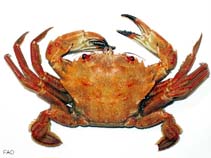Necora puber Linnaeus, 1767
Velvet swimming crabWarning: DOMDocument::load(): SSL operation failed with code 1. OpenSSL Error messages: error:140770FC:SSL routines:SSL23_GET_SERVER_HELLO:unknown protocol in C:\Apache24\htdocs\includes\SpeciesSummary.lib.php on line 1236
Warning: DOMDocument::load(): Failed to enable crypto in C:\Apache24\htdocs\includes\SpeciesSummary.lib.php on line 1236
Warning: DOMDocument::load(https://sealifebase.nrm.se/webservice/AquaMaps/getAMap.php?genus=Necora&species=puber): failed to open stream: operation failed in C:\Apache24\htdocs\includes\SpeciesSummary.lib.php on line 1236
Warning: DOMDocument::load(): I/O warning : failed to load external entity "https://sealifebase.nrm.se/webservice/AquaMaps/getAMap.php?genus=Necora&species=puber" in C:\Apache24\htdocs\includes\SpeciesSummary.lib.php on line 1236
Classification / Names Common names | Synonyms | CoL | ITIS | WoRMS
Malacostraca | Decapoda | Portunidae
Environment: milieu / climate zone / depth range / distribution range Ecology
Benthic; depth range 0 - 80 m (Ref. 356), usually ? - 40 m (Ref. 435). Temperate; 4°C - 28°C (Ref. 112013), preferred 9°C (Ref. 107945); 61°N - 24°N, 16°W - 28°E
Distribution Countries | FAO areas | Ecosystems | Occurrences | Introductions
Atlantic and the Mediterranean Sea: From western Norway to the UK to Western Sahara and the Mediterranean coasts of Spain, France and Italy. Subtropical to temperate.
Length at first maturity / Size / Weight / Age
Maturity: Lm 4.8, range 4 - 5.95 cm Max length : 10.9 cm CL male/unsexed; (Ref. 96051); 9.84 cm CL (female); common length : 4.5 cm CL male/unsexed; (Ref. 435); max. reported age: 8 years (Ref. 96051)
Maximum depth range from Ref. 101396. Maximum carapace width: 8.4; common carapace width: 5.5 cm (Ref. 435). Common in shallow waters from the intertidal to 80 m (Ref. 83653), common at depths not deeper than 40 m (Ref. 435). Found mostly in rocky shores, confined to the lower tidal mark (Refs. 101396). Inhabits on sand or mud (Ref. 435). Carnivore; trophic level 2.6 (Ref. 96418), trophic level 2.98 (Ref. 435). An opportunistic feeder, mostly preys on molluscs and crustaceans and also feeds on detrital material and large quantities of brown algae (Ref. 96482).
Life cycle and mating behavior Maturity | Reproduction | Spawning | Eggs | Fecundity | Larvae
Members of the order Decapoda are mostly gonochoric. Mating behavior: Precopulatory courtship ritual is common (through olfactory and tactile cues); usually indirect sperm transfer.
Main reference
References | Coordinator | Collaborators
SAUP Database. 2006. (Ref. 356)
IUCN Red List Status (Ref. 130435)
CITES status (Ref. 108899)
Not Evaluated
CMS (Ref. 116361)
Not Evaluated
Threat to humans
Human uses
Fisheries: commercial
FAO - Fisheries: landings | FishSource | Sea Around Us
Tools
More information
Internet sources
BHL | BOLD Systems | CISTI | DiscoverLife | FAO(Fisheries: ; publication : search) | Fishipedia | GenBank (genome, nucleotide) | GloBI | Gomexsi | Google Books | Google Scholar | Google | PubMed | Tree of Life | Wikipedia (Go, Search) | Zoological Record
Estimates based on models
Nutrients: Calcium = 109 [35, 184] mg/100g; Iron = 1.59 [1.21, 1.97] mg/100g; Protein = 20.2 [19.2, 21.3] %; Omega3 = 0.285 [0.185, 0.386] g/100g; Selenium = 48.3 [-31.7, 128.3] μg/100g; VitaminA = 0 μg/100g; Zinc = 1.79 [1.17, 2.40] mg/100g (wet weight).



